The Works of John Brown of Haddington (14 vols.)
Digital Logos Edition
This product has been transferred from Community Pricing to Pre-Pub. The actual funding level may be lower than it appears, which could delay production. The amount of funding still needed will be evaluated and updated soon.
Overview
John Brown of Haddington was one of Scotland's most important theological writers from the eighteenth century whose works on faith, worship, doctrine, and spirituality have had an enduring impact on the Church. The fourteen volumes in The Works of John Brown of Haddington (14 vols.) include all of Brown's major theological works, his two-volume Dictionary of the Bible (one of the first of its kind), The Self-Interpreting Bible, and his most important work: A Compendious View of Natural and Revealed Religion, also known as The Systematic Theology of John Brown.
This packed collection includes Brown's personal letters, essays, tracts, sermons, a catechism for children, a concordance of the entire Bible, and more. Also included is Robert Mackenzie's inspirational biography John Brown of Haddington.
With the Logos Bible Software edition, all Scripture passages in The Works of John Brown of Haddington (14 vols.) are tagged and appear on mouse-over. What’s more, Scripture references are linked to the wealth of language resources in your Logos library. This makes these texts more powerful and easier to access than ever before for scholarly work or personal Bible study. With the advanced search features of Logos Bible Software, you can perform powerful searches by topic or Scripture reference—finding, for example, every mention of “grace” or “Psalm 19:1.”
- Over 5,000 pages of John Brown of Haddington's work
- Includes both The Self-Interpreting Bible and A Compendious View of Natural and Revealed Religion
- Includes Robert Mackenzie's biography John Brown of Haddington
- Linked to your preferred Bible
He was known throughout Scotland for his piety and learning, his retired and studious habits, and his earnest desire to throw such a light on the sacred volume as should make all ordinary readers feel it to be an instructive and blessed book. It may, indeed, be said of his literary and biblical labors, as was said of his Divine Master's preaching, 'the common people heard him gladly.'
—The North British Review
- Title: The Works of John Brown of Haddington
- Author: John Brown
- Volumes: 14
- Pages: 5,526
- Resource ID: {A5AE3EA9-A927-40C3-B595-85C99AE6F736}
Individual Titles
- A Compendious View of Natural and Revealed Religion
- The Psalms of David in Metre: With Annotations Explaining the Sense, and Animating the Devotion
- The Christian Journal
- A Dictionary of the Bible, vol. 1
- A Dictionary of the Bible, vol. 2
- An Essay towards an Easy, Plain, Practical, and Extensive Explication of the Assembly's Shorter Catechism
- A Concordance to the Holy Scriptures of the Old and New Testaments
- The Self-Interpreting Bible
- A Compendious History of the British Churches in England, Ireland, and America, vol. 1
- A Compendious History of the British Churches in England, Ireland, and America, vol. 2
- A Brief View of the Figures; and Explication of the Metaphors Contained in Scripture
- A Short Catechism for Young Children
- The Posthumous Works of the Late Rev. Mr. John Brown
- John Brown of Haddington
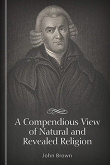
Also known as The Systematic Theology of John Brown, A Compendious View of Natural and Revealed Religion served as a textbook for Brown's seminary students and for laity in his church. It is divided into seven areas of study:
- Of the Regulating Standard of Religion
- Of God, the Author, Object, and End of All Religion
- Of the Covenant Bond of Religious Connection between God and Men
- Of Christ the Mediator of the Covenant of Grace
- Of the Principal Blessings of the Covenant of Grace
- Of the External Dispensation of the Covenant of Grace by Law, Gospel, Etc.
- Of the Church or Society, For and To Which the Covenant of Grace is Dispensed
This masterwork also includes his essay "Address to Students of Divinity."
A most useful and valuable book to ministers and students.
—The Eclectic Review
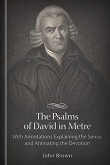
John Brown provides verse-by-verse commentary for each Psalm in meter form. Commentary includes historical information about the Psalms, as well as practical application for one's spiritual life.
It is sufficient for us to say that this is everything that could be desired. It is decidedly the best edition of the Psalms that we have ever seen.
—The Evangelical Repository and United Presbyterian Review
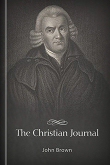
In The Christian Journal, John Brown provides a series of meditations on nature and spirituality divided by the different parts of the year: spring, summer, harvest, and winter. As Brown writes in the preface: "Doth not Jesus, the wisdom of God, draw his instructive, his inestimable parables, from sparrows, fishes, nets, bottles, grains of mustard-seed, dough, and other common objects? Why not may we, though at infinite distance, follow his blessed example?" Also included is a special section of meditations for the Sabbath-day.
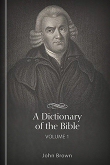
One of the first of its kind, A Dictionary of the Bible provides informative explanations of the people, places, and things of the Bible. Volume one covers letters A–H.
This interesting publication embraces every Subject connected with the Holy Scriptures, and for young people it may be considered as a Theological Library.
—The Edinburgh Review
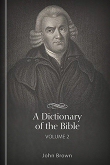
One of the first of its kind, A Dictionary of the Bible provides informative explanations of the people, places, and things of the Bible. Volume two covers letters I–Z.
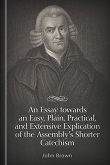
John Brown's Explication of the Assembly's Shorter Catechism was used to educate lay persons, or people new to the faith, in matters of doctrine and belief. In plain, unadorned language, Brown explores and expands the more difficult parts of the catechism.
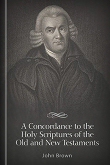
In A Concordance to the Holy Scriptures of the Old and New Testaments, John Brown provides an alphabetical list of principle words used in the Bible, their immediate contexts, and where they can be found in the Scripture.
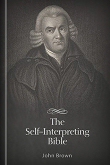
The purpose of The Self-Interpreting Bible was to provide a commentary for the entire Bible that everyone could understand—and its popularity proved its need. From Genesis to Revelation, John Brown uses plain language to explain the Bible.
Also included is An Introduction to the Right Understanding of the Oracles of God which is divided into five chapters of study:
- In the first, Brown presents a collection of arguments in support of the Divine Authority of revelation
- The second contains a large collection of tips for studying the Scriptures
- The third explores Jewish laws and ceremonies—and their connection to the person and Gospel of Christ
- The fourth explores the geography and history of the Near East
- The last chapter exhibits a table of chronology, from the commencement of the church to the consummation of all things
Brown's Bible was treasured in the homes of the people with all the reverence and care enjoyed by Bunyan's Pilgrim's Progress and Boston's Fourfold State.
—Robert Mackenzie,John Brown of Haddington
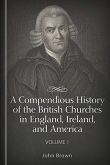
Volume one of A Compendious History of the British Churches in England, Scotland, Ireland, and America includes the history of the churches in England and Ireland, plus a brief historical sketch of the Protestant churches in America. Also included is Brown's Brief Sketch of the History of the Waldenses. The Waldenses, also known as Waldensians or Vaudois, were a persecuted Christian movement of the latter Middle Ages that joined with Protestants during the Reformation.
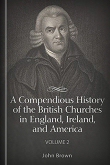
Volume two of A Compendious History of the British Churches in England, Scotland, Ireland, and America includes a thorough history of the Church of Scotland. Also included is Brown's Historical Account of the Rise and Progress of the Secession, a stirring account of the dissenters from the Church of Scotland that formed the United Secession Church.
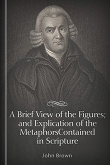
A Brief View of the Figures; and Explication of the Metaphors Contained in Scripture is akin to a biblical concordance, but organized by metaphors respecting persons and things. For instance, explanations for each metaphor concerning "fallen angels" in the Bible are grouped together, as well as notation on where they can be found in the Bible. Other metaphorical groupings include faithful ministers, false teachers, holy angels, saving grace, death, fellowship with God, and more.
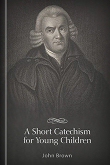
John Brown's Short Catechism for Young Children covers the ten commandments in simple language and provides a question and answer format for questions such as: "Who made you?" and "How does Christ's Spirit enable you to pray?"
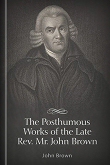
The Posthumous Works of the Late Rev. Mr. John Brown contains essays and tracts that Brown was working on shortly before his death, as well as personal letters and a summary of his dying words by those that were at his bedside. Also includedare his "Dying Advices to His Younger Children" and "Dying Advices to His Congregation," two letters he wrote on his deathbed.
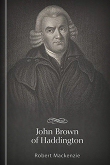
Robert Mackenzie's biography of John Brown tells the inspiring story of how an orphaned shepherd boy became the celebrated teacher and preacher of the Bible we know today. After the death of his parents, Brown worked as a sheep herder to support himself. Converting to Christianity, Brown taught himself to read Greek (this process is a fascinating story in itself), and walked twenty-four miles to buy his first Greek New Testament. In the bookshop, a professor laid out a challenge to the poorly looking shepherd boy: if he could read from the Greek New Testament, the professor would buy it for him. Brown left the shop with his free Greek Bible, and never looked back. In stirring prose, Mackenzie tells the rest of Brown's unlikely rise to one of his country's most popular preachers—and one of Christianity's best apologists.
There are few stories more thrilling than the simple narrative of John Brown of Haddington, as he came to be called. The facts are all given in the fascinating biography by Robert Mackenzie, published in 1918.
—A. T. Robertson, The Minister and His Greek New Testament
Individual Titles
- A Compendious View of Natural and Revealed Religion
- The Psalms of David in Metre: With Annotations Explaining the Sense, and Animating the Devotion
- The Christian Journal
- A Dictionary of the Bible, vol. 1
- A Dictionary of the Bible, vol. 2
- An Essay towards an Easy, Plain, Practical, and Extensive Explication of the Assembly's Shorter Catechism
- A Concordance to the Holy Scriptures of the Old and New Testaments
- The Self-Interpreting Bible
- A Compendious History of the British Churches in England, Ireland, and America, vol. 1
- A Compendious History of the British Churches in England, Ireland, and America, vol. 2
- A Brief View of the Figures; and Explication of the Metaphors Contained in Scripture
- A Short Catechism for Young Children
- The Posthumous Works of the Late Rev. Mr. John Brown
- John Brown of Haddington

Also known as The Systematic Theology of John Brown, A Compendious View of Natural and Revealed Religion served as a textbook for Brown's seminary students and for laity in his church. It is divided into seven areas of study:
- Of the Regulating Standard of Religion
- Of God, the Author, Object, and End of All Religion
- Of the Covenant Bond of Religious Connection between God and Men
- Of Christ the Mediator of the Covenant of Grace
- Of the Principal Blessings of the Covenant of Grace
- Of the External Dispensation of the Covenant of Grace by Law, Gospel, Etc.
- Of the Church or Society, For and To Which the Covenant of Grace is Dispensed
This masterwork also includes his essay "Address to Students of Divinity."
A most useful and valuable book to ministers and students.
—The Eclectic Review

John Brown provides verse-by-verse commentary for each Psalm in meter form. Commentary includes historical information about the Psalms, as well as practical application for one's spiritual life.
It is sufficient for us to say that this is everything that could be desired. It is decidedly the best edition of the Psalms that we have ever seen.
—The Evangelical Repository and United Presbyterian Review

In The Christian Journal, John Brown provides a series of meditations on nature and spirituality divided by the different parts of the year: spring, summer, harvest, and winter. As Brown writes in the preface: "Doth not Jesus, the wisdom of God, draw his instructive, his inestimable parables, from sparrows, fishes, nets, bottles, grains of mustard-seed, dough, and other common objects? Why not may we, though at infinite distance, follow his blessed example?" Also included is a special section of meditations for the Sabbath-day.

One of the first of its kind, A Dictionary of the Bible provides informative explanations of the people, places, and things of the Bible. Volume one covers letters A–H.
This interesting publication embraces every Subject connected with the Holy Scriptures, and for young people it may be considered as a Theological Library.
—The Edinburgh Review

One of the first of its kind, A Dictionary of the Bible provides informative explanations of the people, places, and things of the Bible. Volume two covers letters I–Z.

John Brown's Explication of the Assembly's Shorter Catechism was used to educate lay persons, or people new to the faith, in matters of doctrine and belief. In plain, unadorned language, Brown explores and expands the more difficult parts of the catechism.

In A Concordance to the Holy Scriptures of the Old and New Testaments, John Brown provides an alphabetical list of principle words used in the Bible, their immediate contexts, and where they can be found in the Scripture.

The purpose of The Self-Interpreting Bible was to provide a commentary for the entire Bible that everyone could understand—and its popularity proved its need. From Genesis to Revelation, John Brown uses plain language to explain the Bible.
Also included is An Introduction to the Right Understanding of the Oracles of God which is divided into five chapters of study:
- In the first, Brown presents a collection of arguments in support of the Divine Authority of revelation
- The second contains a large collection of tips for studying the Scriptures
- The third explores Jewish laws and ceremonies—and their connection to the person and Gospel of Christ
- The fourth explores the geography and history of the Near East
- The last chapter exhibits a table of chronology, from the commencement of the church to the consummation of all things
Brown's Bible was treasured in the homes of the people with all the reverence and care enjoyed by Bunyan's Pilgrim's Progress and Boston's Fourfold State.
—Robert Mackenzie,John Brown of Haddington

Volume one of A Compendious History of the British Churches in England, Scotland, Ireland, and America includes the history of the churches in England and Ireland, plus a brief historical sketch of the Protestant churches in America. Also included is Brown's Brief Sketch of the History of the Waldenses. The Waldenses, also known as Waldensians or Vaudois, were a persecuted Christian movement of the latter Middle Ages that joined with Protestants during the Reformation.

Volume two of A Compendious History of the British Churches in England, Scotland, Ireland, and America includes a thorough history of the Church of Scotland. Also included is Brown's Historical Account of the Rise and Progress of the Secession, a stirring account of the dissenters from the Church of Scotland that formed the United Secession Church.

A Brief View of the Figures; and Explication of the Metaphors Contained in Scripture is akin to a biblical concordance, but organized by metaphors respecting persons and things. For instance, explanations for each metaphor concerning "fallen angels" in the Bible are grouped together, as well as notation on where they can be found in the Bible. Other metaphorical groupings include faithful ministers, false teachers, holy angels, saving grace, death, fellowship with God, and more.

John Brown's Short Catechism for Young Children covers the ten commandments in simple language and provides a question and answer format for questions such as: "Who made you?" and "How does Christ's Spirit enable you to pray?"

The Posthumous Works of the Late Rev. Mr. John Brown contains essays and tracts that Brown was working on shortly before his death, as well as personal letters and a summary of his dying words by those that were at his bedside. Also includedare his "Dying Advices to His Younger Children" and "Dying Advices to His Congregation," two letters he wrote on his deathbed.

Robert Mackenzie's biography of John Brown tells the inspiring story of how an orphaned shepherd boy became the celebrated teacher and preacher of the Bible we know today. After the death of his parents, Brown worked as a sheep herder to support himself. Converting to Christianity, Brown taught himself to read Greek (this process is a fascinating story in itself), and walked twenty-four miles to buy his first Greek New Testament. In the bookshop, a professor laid out a challenge to the poorly looking shepherd boy: if he could read from the Greek New Testament, the professor would buy it for him. Brown left the shop with his free Greek Bible, and never looked back. In stirring prose, Mackenzie tells the rest of Brown's unlikely rise to one of his country's most popular preachers—and one of Christianity's best apologists.
There are few stories more thrilling than the simple narrative of John Brown of Haddington, as he came to be called. The facts are all given in the fascinating biography by Robert Mackenzie, published in 1918.
—A. T. Robertson, The Minister and His Greek New Testament
John Brown (1722–1787) was born at Carpow in the parish of Abernethy, in Pershire Scotland. Around the age of twelve, his parents died and Brown supported himself as a shepherd. After teaching himself Latin, Hebrew, and Greek, Brown would work as a schoolmaster, briefly as a volunteer soldier, and eventually would become a student of divinity in the Secession Church. He was ordained as a minister at Haddington, East Lothain, in 1751, where he remained for the rest of his life. While continuing his duties as a minister, Brown also took the position of Professor of Divinity and began to publish works to great acclaim. Brown had six children, four of whom became ministers, and one that became the provost of Haddington.
Reviews
6 ratings

Sandro Polenta
8/1/2023
Out of the 14 mentioned resources, only one is ready to be delivered, what about the others? Any timeline? Somebody working on it?
Philip K. Eyrich
3/12/2023
The Self-Interpreting Bible's cross references and notes make this an excellent resource.
Daniel Caballero
8/3/2019

Matthew John Buttner
8/14/2016
How can the Self-Interpreting Bible be only 365 pages? This was originally a three or four volume Bible with tons of notes and 200,000 cross references. What gives?
Brian Huddleston
6/1/2014

Phil Gons
7/14/2013

Abraham Serey
1/9/2013
If you are about to publish this material, it would be good that they could work more Puritans in Spanish, a translator or adding logos to the library, to change the language of books.